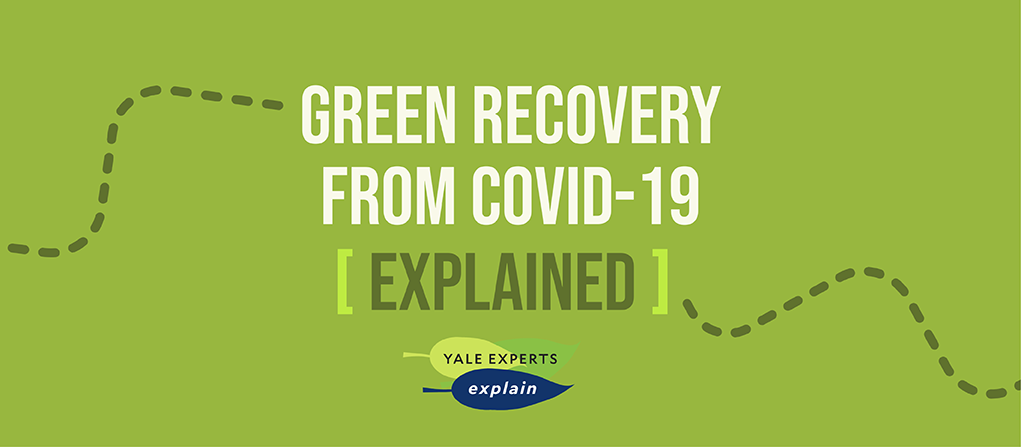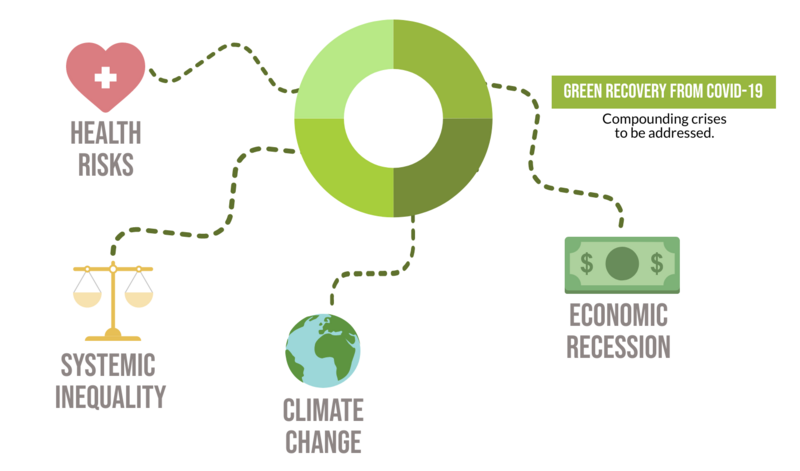
July 30, 2021
Climate and health experts Dr. Laura Bozzi and Dr. Narasimha Rao break down what it means to “build back better” from the pandemic.
What are the compounding crises that we are experiencing during the COVID-19 pandemic?
Dr. Laura Bozzi, Director of Programs at the Yale Center on Climate Change and Health, describes what we have experienced over the past year as a “constellation of crises [which] will be with us for a while.” These crises involve the COVID-19 pandemic, which has killed over 2.6 million people worldwide, as well as the economy, public mental health, systemic racial and social injustices, and climate change.
“There have been severe economic disruptions resulting from our measures to try to prevent the spread of COVID,” says Dr. Narasimha Rao, Associate Professor at the Yale School for the Environment. “Lockdowns, for example, have had a negative effect on employment and spending. This has had recessionary implications, and people have been pushed into poverty.”
Mental health issues have been exacerbated by these economic stressors, as well as the isolation, fear, and uncertainty due to the pandemic and ongoing examples of racism. Accompanying these daily crises is what our experts describe as the “looming crisis” of climate change.
“Slowly but surely, we have been experiencing the impacts of climate change first hand, as we see in examples of devastating wildfires, hurricanes, and other extreme weather events,” Rao says. “This adds a new layer of risk and stress to communities, infrastructure, and economies worldwide, and we are not yet prepared to handle them.”
Importantly, the health, financial, social, and climate crises and resulting impacts are not identically experienced across society. Communities of color are disproportionately at risk of infection of and death by COVID-19 as they are more likely to have riskier jobs, live in crowded housing, and experience exposure to environmental hazards. This among other factors also puts them at risk for financial hardship.
“There are people who are in frontline work that is highly dangerous, but cannot afford to stay home,” Bozzi adds. “There are people whose jobs and incomes haven’t been affected at all, while others have lost their jobs without many opportunities for regaining employment. The economic consequences are both long standing, and really inequitable.”
Just like the inequities persisting within each individual crisis, the interaction of these compounding crises is also experienced differently based on social and racial factors.
“People of color and low-income communities are facing the disproportionate impact of many of these crises together,” Rao says. “These communities don’t always have a social net, and are more vulnerable to economic shocks, more vulnerable to health risks, and more vulnerable to the effects of climate change.”
What is a green recovery?
In response to these compounding environmental, economic, social, and health crises–and the inequitable impacts of them–there are calls for a “green recovery.” A green recovery brings economies out of recession through redesign to reduce our greenhouse gas emissions, create jobs, increase the resilience of infrastructure and communities, and prioritize equity.
“The basis of the inclusive green recovery is a possibility to reimagine where we want to go as a society from here, in terms of improving livelihoods and fighting climate change,” Bozzi explains. “After a big economic impact like this, there is a government push toward restarting the economy. We can do that in traditional ways, or we could try to multi-solve to address the many compounding crises we see.”

Rao agrees, framing this moment in time as an “opportunity for policy makers to protect people’s health, recover from the economic recession, and mitigate and adapt to climate change”.
“We have been wanting to make a significant boost in spending towards combating climate change anyway, and now we have these economic shocks in need of our attention and funding,” Rao explains. “If we dovetail these efforts, we can actually have a more positive social benefit than if those would have occurred separately.”
What are the equitable solutions proposed by green recovery efforts?
A green recovery is not characterized by one single action or effort. There are a wide range of solutions that help advance the goals of a green recovery, including policies, investments, retrofits, community programs, academic projects, and more.
In practice, Rao explains that a green recovery can take the form of investments in things like an equitable transition to green energy and sustainable transportation infrastructure, retrofits to buildings and homes, or improvements made to urban green spaces. Investments in these sectors will both reduce emissions and create jobs.
Bozzi adds that these investments can be bolstered by green workforce training programs. These programs work to retrain individuals to have the skills to contribute to green infrastructure such as renewable energy systems, electric vehicle manufacturing, urban forestry and green space management, and more.
Solutions can even take the form of small community projects. Bozzi offers an idea for a multicultural art project at a dangerous intersection in one’s city.
“Not only are you making the city safer for sustainable modes of transportation like biking and walking, but you’re also helping to beautify the city, support local small businesses lining that street, and help people feel connected to their neighborhood and to each other,” she says. “This is what a green recovery is about.”
The solutions posed by the principles of a green recovery can happen at multiple scales internationally and be complementary to one another. In the U.S. context, our experts agree that leaders and organizations at the municipal, state, and federal levels should all be prioritizing this work and integrating it into recovery funds.
Bozzi explains that regardless of format or scale, what remains central to each solution is that it should “create jobs or stimulate the economy, decarbonize the economy, and elevate the voices of people who have been excluded from the design of their society well before the pandemic.”
Who benefits from a green recovery?
It depends on the design of green recovery policies and measures.
“It’s not only important how much we invest in green recovery efforts, but where and what we invest it in,” Rao states.
Generally, advancing policy and investing in infrastructure that will reduce greenhouse gas emissions benefit everyone around the globe, particularly those who are most vulnerable to impacts of climate change like sea level rise. Rao explains that while decarbonization efforts have a “general social public benefit” on a more granular scale, specific efforts can either move us towards justice or perpetuate inequities. He gives the example of investing in electric vehicle infrastructure versus public transportation. Both reduce emissions, but the beneficiaries differ.
“If we invest in purely electric vehicle infrastructure, the immediate beneficiaries will be those who are getting jobs from manufacturing EVs and installing the infrastructure,” Rao explains. “However, the distribution of EVs happens at the highest income levels and it takes a long time for it to trickle down to lower income levels. If we invest in public transit, we are immediately benefitting low income communities, who are the people who use this form of transportation the most.”
The geography of these efforts matters, too.
“If we invest in public transit infrastructure in geographic regions where you have a high concentration of jobs held by low-income communities, you boost equity further,” Rao says.
This is just one example of how beneficiaries of green recovery efforts change depending on the geography and sector of investments, which might include transportation, buildings and public housing, energy, air quality, and more.
“That’s the crux of it,” Bozzi adds. “Are we going to design it to help make a rapid recovery for those who have been most left behind? Or will it continue to benefit those that already have political and economic power? It is up to us as a society to identify just solutions and make sure they happen.”
What is needed to implement these solutions?
Achieving an inclusive green recovery involves the continued coordination of multiple pieces happening at multiple scales. The key pieces include research, policies, funding, and multisectoral partnerships.
Community listening will play an important role in the research component of this work. Rao explains that designing an inclusive green recovery effort will involve improved mechanisms for stakeholder engagement and empowerment that will allow researchers and policy makers to deepen their knowledge around the health, economic, and climate risks people are facing.
“We need to find new and better ways to systematically gain knowledge from those who are most disadvantaged, as they do not have the kinds of channels for lobbying efforts that more privileged players in the economy do,” Rao says.
However, even if the design of the principles and policies are inclusive, our experts expect that green recovery efforts will almost certainly face political opposition.
“Because of COVID, there is more of a recognition that climate change is happening and that we need to address it, and yet we could hear, ‘We need to deal with today’s crisis today, and we’ll deal with tomorrow’s crisis tomorrow’,” Bozzi explains. “But we will need to reinforce, that while it is harder to solve these multiple crises at once, we don’t have time to wait.”
How can individuals play a role in a green recovery?
Our experts agree that when it comes to supporting a green recovery, it is the ultimate priority of individuals to strengthen their political engagement with these issues. This engagement can happen from the local to federal scale.
“As an individual, you can advocate for green recovery principles in your community by calling for policy change,” Bozzi says. “Make sure that your legislators know loud and clear that this is something you want to see them commit to.”
Beyond interacting with policymakers, in everyday life, individuals can also use their platform and their connections to advocate for a recovery that is equitable and that addresses climate change.
“Speak openly about these issues, especially if you are in a position of privilege,” Rao says. “Wherever you are involved in your community, whether it is in a church, a student group, or a community board, speak about what you understand to be the key needs in society.”
What is Yale Doing?
Yale Facilities is a strong proponent of local workforce development and has created new opportunities for skills training in recent years. An apprenticeship program provides current Yale employees the opportunity to learn a trade and advance to a higher level, specifically in the areas of painting, plumbing, electrical, and HVAC (heating, ventilation, and air conditioning). By creating opportunities to study these trades and do hands-on training with projects on Yale’s campus, the university is helping create a local, skilled workforce and green jobs to enable both the university and the New Haven region implement necessary changes toward a more sustainable built environment.